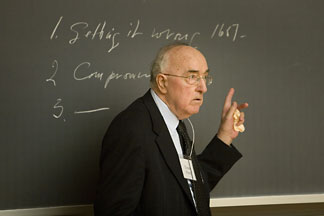Wine expert tells alumni of U.S. wine's tumultuous history
By Laura Janka

"Good wine is a necessity of life for me," said Thomas Jefferson.
The founding father's words are on display in the Cornell Library Division of Rare and Manuscript Collections' newest exhibition, "Song of the Vine: A History of Wine." To mark the exhibit's opening, author Thomas Pinney lectured Cornell alumni on the history of wine in America June 5 in Hollis E. Cornell Auditorium.
Pinney, author of the two-volume "A History of Wine in America," took his audience through the turbulent journey of the American viticulture industry. "The story of wine in America has a very simple theme," he said. "You might call it overcoming difficulties."
Today, vineyards and wineries in all 50 states contribute to U.S. rankings as the fourth largest wine-producing nation, behind France, Italy and Spain. Yet Pinney urged his audience to "keep in mind the powerful obstacles that lay in the way of successful winemaking in [the United States]; they were daunting and difficult."
Despite a strong European wine tradition and colonial charters that listed winemaking as a goal, American wine production was "a complete comprehensive failure" until about 1807. Native grape varieties were unsuitable, Pinney said. Early settlers imported vinifera grape varieties, the backbone of European wine production and the standard for flavor. But the U.S. climate and pathogens prevented them from flourishing. Hybrids that blended European flavors with American resistance were introduced, and the vines survived.
As the 19th century progressed, American wineries gained commercial success, particularly in California and Missouri. The years following the Civil War saw a steady increase in viticulture across the nation, and local winemaking was prevalent.
The rise of the temperance movement halted wine research, and Prohibition left its mark: Pinney noted that it was not until around 1960 that the United States began "getting it right."
By the 1960s, Pinney explained, the American palate had evolved from a preference for sweet dessert wines to a taste for dry table wines. Integral to this revolution was the work of Russian immigrant Konstantin Frank, who researched winter hardiness with vinifera grapes and in 1962 founded Vinifera Wine Cellars in Hammondsport, N.Y. A wine tasting at the exhibit opening offered samples of the winery's most recent wines.
"Song of the Vine: A History of Wine," in Kroch Library's Hirshland Gallery, runs until Jan. 16, 2009.
Laura Janka '09 is a writer intern at the Cornell Chronicle.
Media Contact
Get Cornell news delivered right to your inbox.
Subscribe